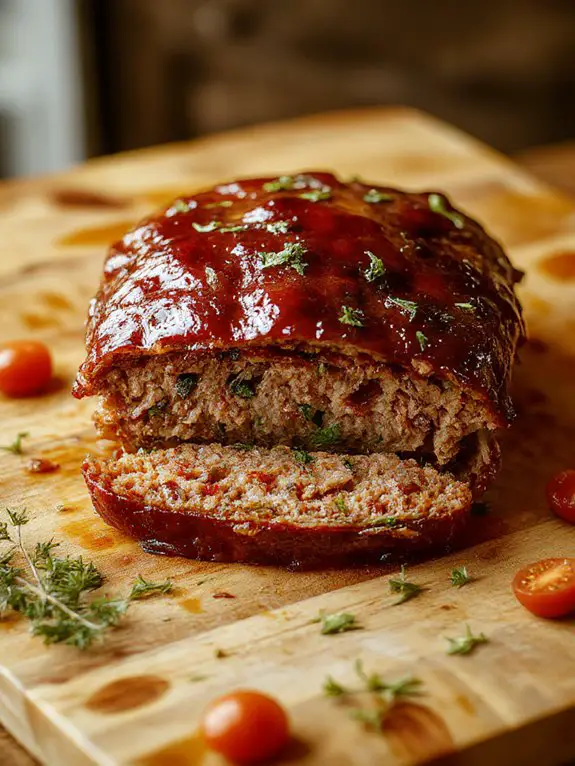I’ve spent years perfecting this meatloaf recipe, and I’ll share what makes it different from the countless versions you’ve probably tried. The secret isn’t just in the meat blend or the glaze—though both matter more than you’d think. It’s in three specific techniques that transform ordinary ingredients into something your family will actually request for dinner again.
Meatloaf Recipe

I can promise you with absolute certainty that this is the meatloaf recipe that will change everything you thought you knew about this classic comfort food. After making countless variations over the years, I’ve cracked the code to creating a meatloaf that’s incredibly moist and tender on the inside with a beautifully caramelized exterior that’s packed with savory depth.
The secret lies in my trio of ground meats—beef, pork, and veal—combined with a splash of Worcestershire sauce and a hint of smoked paprika that adds an irresistible smokiness you’ll taste in every single bite. What really sets this apart is the glaze that gets brushed on halfway through baking, creating this gorgeous mahogany crust that’s slightly sweet and tangy, perfectly complementing the rich, herb-infused meat beneath.
I’ve served this to the pickiest eaters and the most sophisticated palates, and without fail, everyone goes back for seconds, asking what makes it so incredibly flavorful and why the texture is so perfectly balanced—never dense or dry like so many meatloaves can be.
The aroma alone will have your kitchen smelling like pure comfort, and when you slice into it, you’ll see those beautiful, even layers that hold together perfectly while still being fork-tender. This is the kind of recipe that turns a simple weeknight dinner into something special, and I guarantee once you make it, it’ll become your go-to meatloaf forever.
Ingredients

Creating the perfect meatloaf starts with understanding that this isn’t just about throwing ground meat into a pan—it’s about building layers of flavor and texture that’ll make your family beg for seconds.
The secret lies in choosing the right blend of ingredients that work together to create moisture, binding, and that irresistible savory depth that separates homemade meatloaf from the dry, flavorless versions you might remember from childhood.
The Meat Foundation:
- 1½ pounds ground beef (80/20 blend) – This fat ratio is NON-NEGOTIABLE for juicy results; lean meat = dry disappointment
- ½ pound ground pork – The secret weapon for extra richness and moisture (substitute with ground veal or more beef if needed)
The Binding Brigade:
- 1 large egg – Acts as the glue holding everything together
- ¾ cup breadcrumbs – Fresh is best, but panko or even crushed crackers work in a pinch
- ½ cup whole milk – Creates steam while cooking for incredible tenderness (buttermilk adds tangy depth if you have it)
The Flavor Builders:
- 1 medium onion, finely diced – Yellow onions are perfect; sweet onions work too, but skip the red ones here
- 3 cloves garlic, minced – Fresh only—powdered just won’t deliver that punch
- 2 tablespoons Worcestershire sauce – This umami bomb is absolutely essential for that savory complexity
- 1 tablespoon ketchup – Yes, in the mix AND on top later
The Seasoning Stars:
- 1 teaspoon salt – Kosher salt distributes better than table salt
- ½ teaspoon black pepper – Freshly cracked makes a difference
- 1 teaspoon dried thyme – Fresh herbs work too (use 1 tablespoon)
- ½ teaspoon smoked paprika – The secret ingredient that adds depth without heat
The Glorious Glaze:
- ⅓ cup ketchup – The classic choice that caramelizes beautifully
- 2 tablespoons brown sugar – Creates that gorgeous, glossy finish
- 1 tablespoon apple cider vinegar – Cuts through the richness perfectly
How to Make the Best Meatloaf

• Preheat your oven to 350°F and lightly grease a 9×5-inch loaf pan or line a rimmed baking sheet with parchment paper.
Setting up your workspace first means no scrambling later when your hands are messy from mixing. The rimmed baking sheet gives you more surface area for that coveted crispy exterior, while a loaf pan creates the classic shape—your choice! Greasing prevents sticking, but don’t go overboard or your meatloaf might slide around.
• In a large mixing bowl, gently combine 2 pounds ground beef (80/20 blend), 1 cup fine breadcrumbs, 1/2 cup milk, 1 beaten egg, 1 diced onion, 2 minced garlic cloves, 1 teaspoon salt, and 1/2 teaspoon black pepper.
The 80/20 ground beef ratio is your sweet spot—enough fat for flavor and moisture without being greasy. Mix with your hands or a fork using a light touch, as if you’re folding laundry rather than kneading bread dough.
Overmixing develops the proteins too much, resulting in a dense, tough meatloaf that resembles a hockey puck more than dinner.
• Test the seasoning by cooking a small spoonful of the mixture in a skillet until cooked through, then taste and adjust salt and pepper as needed.
This 30-second step saves dinner! Raw meat mixture tastes like nothing, so this little test patty tells you exactly what your finished meatloaf will taste like. Don’t skip this—under-seasoned meatloaf is disappointingly bland, and you can’t fix it after it’s baked.
• Shape the mixture into a loaf on your prepared baking sheet or gently press it into your loaf pan, creating a slightly domed top.
For freeform loaves, aim for about 9 inches long and 5 inches wide—this helps maintain even cooking. The slight dome helps shed the glaze beautifully and prevents a flat, sad-looking result.
If using a loaf pan, don’t pack it down hard; just nestle it in gently to maintain that tender texture.
• Whisk together 1/2 cup ketchup, 2 tablespoons brown sugar, 1 tablespoon apple cider vinegar, and 1 teaspoon Worcestershire sauce in a small bowl until smooth.
This glaze hits all the flavor notes—sweet, tangy, and savory. The brown sugar caramelizes beautifully in the oven, while the vinegar cuts through the richness. Confirm the brown sugar dissolves completely; lumpy glaze looks messy and tastes uneven.
• Brush half the glaze over the top and sides of the uncooked meatloaf, reserving the remaining glaze for later.
Think of this first coat as a flavor foundation that will concentrate and intensify as it bakes. Don’t dump it all on now—you want that final glaze application to create a glossy, fresh-looking finish. A pastry brush works best, but a spoon works in a pinch.
• Bake for 45 minutes, then remove and brush with the remaining glaze.
At this point, your meatloaf should be set but not quite done, and the first glaze layer will look beautifully caramelized. The second glaze application creates that magazine-worthy glossy finish and adds a fresh burst of flavor that won’t taste overcooked.
• Continue baking for 10-15 minutes more, until the internal temperature reaches 160°F and the glaze is glossy and slightly caramelized.
A meat thermometer is your best friend here—no guessing games. Insert it into the thickest part of the loaf for an accurate reading. The glaze should look shiny and rich, not burnt or dried out. If it’s browning too quickly, tent with foil for the last few minutes.
• Let the meatloaf rest for 10 minutes before slicing to allow the juices to redistribute and the structure to firm up.
This rest time is vital—slice too early and all those delicious juices run out onto your cutting board instead of staying in the meat. Use this time to make gravy from the pan drippings or warm up your sides. A sharp knife and gentle sawing motion will give you clean, Instagram-worthy slices.
Chef Tips

While following a recipe gets you great results, a few insider tricks can transform your good meatloaf into an exceptional one that’ll have your family asking for seconds.
I recommend using proper seasoning techniques like salting the meat mixture thirty minutes before cooking.
For cooking methods, I always use a meat thermometer to guarantee perfect doneness every time.
Nutrition

This classic meatloaf recipe provides a balanced combination of protein, carbohydrates, and essential nutrients. The nutritional values below are calculated per serving, assuming the recipe serves 8 people.
| Nutrient | Amount per Serving |
|---|---|
| Calories | 285 |
| Total Fat | 15g |
| Saturated Fat | 6g |
| Cholesterol | 95mg |
| Sodium | 520mg |
| Total Carbohydrates | 12g |
| Dietary Fiber | 1g |
| Sugars | 3g |
| Protein | 26g |
| Vitamin A | 8% DV |
| Vitamin C | 4% DV |
| Calcium | 6% DV |
| Iron | 15% DV |
What You’ll Love About This Meatloaf Recipe

This meatloaf recipe brings together everything you want in a comfort food classic, with a few smart tweaks that make it absolutely foolproof. Whether you’re feeding a hungry family on a weeknight or looking for something that feels like a warm hug on a plate, this recipe delivers every single time.
- Simple ingredients you probably already have – No need for a special grocery run since this recipe uses everyday pantry staples and basic ground beef, making it perfect for those nights when you need dinner but haven’t planned ahead.
- Stays incredibly moist and flavorful – The secret combination of milk-soaked breadcrumbs and a special glaze keeps every slice tender and juicy, so you’ll never end up with that dry, crumbly meatloaf that nobody wants to finish.
- Makes amazing leftovers – This meatloaf actually tastes even better the next day, and it makes the most incredible sandwiches for lunch, which means you’re basically getting two meals out of one easy recipe.
Frequently Asked Questions
Can I Make Meatloaf Ahead of Time and Freeze It?
Yes, you can! I recommend proper meatloaf preparation by shaping it first, then wrapping tightly in plastic wrap and foil. These freezing techniques preserve quality for up to three months before cooking.
What’s the Best Way to Reheat Leftover Meatloaf?
I’ll share the best reheat methods for your leftover meatloaf. Slice it first, then use your oven at 350°F for 10-15 minutes or microwave with damp paper towel. These leftover tips prevent drying out.
How Do I Prevent My Meatloaf From Falling Apart When Slicing?
I guarantee my meatloaf holds together by using proper binding agents like eggs and breadcrumbs, then letting it rest after baking. The loaf shape firms up during cooling, making clean slices possible.
Can I Substitute Ground Turkey or Chicken for Ground Beef?
Yes, I recommend both substitutions! Turkey benefits include lower fat content and mild flavor, while chicken alternatives work perfectly too. You’ll get a lighter, healthier meatloaf that holds together just as well.
Why Did My Meatloaf Turn Out Dry and How Can I Fix It?
Your meatloaf likely turned out dry due to poor moisture retention from incorrect ingredient ratios. I’d add more eggs, breadcrumbs soaked in milk, or finely diced vegetables to increase moisture content next time.





